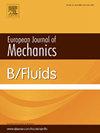Vertical concentration distribution of fine settling particles in a pulsatile laminar open channel flow
IF 2.5
3区 工程技术
Q2 MECHANICS
引用次数: 0
Abstract
Sedimentation in river and drainage systems frequently increases flood risks, making the study of particle dispersion crucial for effective flood damage control. In the present research, the transport of fine settling particles in a laminar, periodic flow through an open channel is analytically investigated using the multi-scale homogenization method. To investigate how settling velocity affects the dispersion process of fine particles in a tidal wetland, Dhar et al. (2022) studied the dispersion coefficient and mean concentration of the settling particles applying the method of moments. The mean and transverse real concentration distributions of settling particles are analytically derived from the governing equation, and the influence of settling velocity, oscillation Reynolds number, and Schmidt number on the dispersivity and concentration profile of the settling particles is investigated. The results show a vertical non-uniformity of longitudinal concentration distribution due to the introduction of settling velocity. It is also observed that the sedimentation effect for purely oscillatory flow is negligibly small compared to that of the steady and oscillatory flow with a nonzero mean. Pulsatile behavior is observed in the difference rate profile between Taylor’s mean and present mean concentration. The study sheds light on the behavior of settling particles and can be useful for understanding sedimentation and wastewater treatment processes.
脉动层流明渠流中细小沉降颗粒的垂直浓度分布
河流和排水系统中的沉积物经常会增加洪水风险,因此研究颗粒的分散对有效控制洪水灾害至关重要。本研究采用多尺度均质化方法,对流经明渠的层流、周期性流动中细小沉降颗粒的输运进行了分析研究。为了研究沉降速度如何影响潮汐湿地中细颗粒的扩散过程,Dhar 等人(2022 年)采用矩量法研究了沉降颗粒的扩散系数和平均浓度。根据控制方程分析得出了沉降颗粒的平均浓度分布和横向实际浓度分布,并研究了沉降速度、振荡雷诺数和施密特数对沉降颗粒的分散性和浓度分布的影响。结果表明,由于引入了沉降速度,纵向浓度分布出现了垂直不均匀性。同时还观察到,与平均值不为零的稳定流和振荡流相比,纯振荡流的沉降效应小得可以忽略不计。在泰勒平均浓度和当前平均浓度之间的差率曲线中观察到了脉动行为。这项研究揭示了沉降颗粒的行为,有助于理解沉降和废水处理过程。
本文章由计算机程序翻译,如有差异,请以英文原文为准。
求助全文
约1分钟内获得全文
求助全文
来源期刊
CiteScore
5.90
自引率
3.80%
发文量
127
审稿时长
58 days
期刊介绍:
The European Journal of Mechanics - B/Fluids publishes papers in all fields of fluid mechanics. Although investigations in well-established areas are within the scope of the journal, recent developments and innovative ideas are particularly welcome. Theoretical, computational and experimental papers are equally welcome. Mathematical methods, be they deterministic or stochastic, analytical or numerical, will be accepted provided they serve to clarify some identifiable problems in fluid mechanics, and provided the significance of results is explained. Similarly, experimental papers must add physical insight in to the understanding of fluid mechanics.

 求助内容:
求助内容: 应助结果提醒方式:
应助结果提醒方式:


